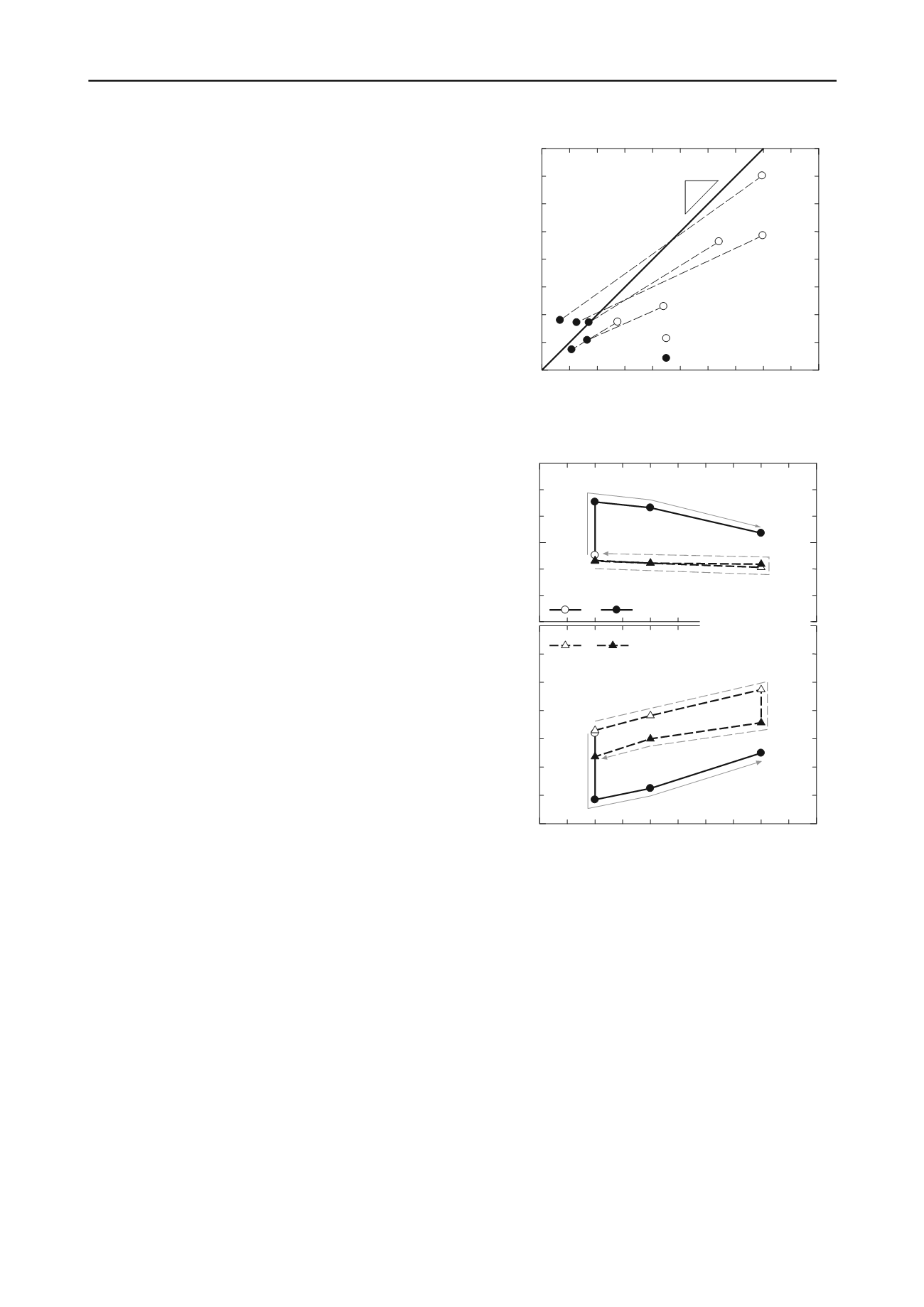
360
Proceedings of the 18
th
International Conference on Soil Mechanics and Geotechnical Engineering, Paris 2013
Proceedings of the 18
th
International Conference on Soil Mechanics and Geotechnical Engineering, Paris 2013
than 10 MPa irrespective of the magnitude of
e
before freezing
or increase/decrease in e after freeze-thaw cycles.
Figure 8 illustrates changes in
G
vh
and
G
hh
after freeze-thaw
cycles. The decrease in
G
hh
is not so remarkable as that in
G
vh
,
probably because the latter results from the velocity of the shear
wave that traverses structurally weak zones formed by
disappearance (melting) of ice lenses. The structural damages
due to formation and disappearance of ice lenses are thus
believed to greatly influence the deformation-strength properties
of soil, in agreement with the results shown in Figure 6. The
fact that
G
vh
is higher than
G
hh
before freezing may be due to
v
acting on the specimen to a greater extent than the horizontal
stress
h
(Yamashita and Suzuki 2001, Roesler 1979).
Figure 9 represents changes in
G
vh
and
e
under stepwise
stress cycles in the two tests mentioned above. The decrease in
G
vh
by freeze-thaw cycles under
v
=40 kPa is smaller than in
the other test because of a very small change in
e
during the
cycle. While freeze-thaw cycles do not greatly influence the
effect of
v
on changes in
G
vh
, they lower
G
vh
to a considerably
greater extent than do
v
changes, and
G
vh
cannot be restored by
loading or unloading in any of the tests. This suggests that
structural damages in soil due to formation and disappearance
of ice lenses are not readily restored
0
10
20
30
40
50
0
10
20
30
40
Figure 8. Changes in
G
vh
and
G
hh
by freeze-thaw cycles
Elastic shear modulus,
G
hh
(MPa)
Sample V
: Before freeze−thaw cycle
: After freeze−thaw cycle
1
1
Elastic shear modulus,
G
vh
(MPa)
The results described above indicate that changes in the
permeability of soil exposed to freeze-thaw cycles can be
explained to in terms of changes in the void ratio
e
, but its
deformation-strength property is not fully described in terms of
changes in
e
because of effects of structural damages in the soil
resulting from formation and disappearance of ice lenses.
4 CONCLUSIONS
i)
U
h
and
ξ
of compacted fine grain soil are lower for higher
e
before freezing, and converge to fairly constant values after
freeze-thaw cycles.
ii) Changes in
k
follow those in
e
due to freeze-thaw cycles.
iii) The initial stiffness and
max
in the constant pressure box
shear tests were greater before freeze-thaw cycles irrespective
of increase or decrease in
e
due to freeze-thaw cycles.
iv) Decrease in
G
vh
is considerable and greater than that in
G
hh
irrespective of
e
before freezing or increase/decrease in e due to
freeze-thaw cycles.
v) Results of the box shear tests and BE tests suggest that
structural damages resulting from formation and disappearance
of ice lenses have marked influence on the deformation-strength
properties of soil.
vi) Results of BE tests with different vertical stresses before
and after freeze-thaw cycles suggest that structural damages
resulting from formation and disappearance of ice lenses cannot
be readily restored.
5 REFERENCES
Ueno, K., Rui, D., Nakamura, D., Ito, Y., Yamashita, S. and Suzuki, T.
2010. Behavior of vegetation protection slopes during freezing and
thawing,
Japanese Geotechnical Journal
, 5(3): 413-424 (in
Japanese).
Kawaguchi, T., Mitachi, T. and Shibuya, S. 2001. Evaluation of shear
wave travel time in laboratory bender element test,
Proc. of the
15th ICSMGE
, 1: 155-158.
Yamashita, S. and Suzuki, T. 2001. Small strain stiffness on anisotropic
consolidated state of sands by bender elements and cyclic loading
tests,
Proc. of the 15th ICSMGE
, 1: 325-328.
Nakamura, D., Suzuki, T., Goto, T., Kim, H., Ito, Y. and Yamashita, S.
2011. Changes in the permeability coefficient and the void ratio of
compacted soil by the effect of freeze-thaw cycles,
Journal of
JSCE
, C, 67(2): 264-275 (in Japanese).
Ono, T., Kodama, D. and Kato, T. 2003. The properties of normally and
overconsolidated clay after freezing and thawing history,
Journal of
JSCE
, 743(III-64): 47-57 (in Japanese).
Chamberlain, E., Iskandar, I. and Hunsicker, S. E. 1990. Effect of
freeze-thaw cycles on the permeability and microstructure of soils,
Cold Region Research and Engineering Laboratory
, 90(1): 145-
155.
Starke, J. O. 1989. Effect of freeze-thaw weather conditions on
compacted clay liners,
Proc. of the 12th Annual Waste Conference
:
412-420.
Aoyama, K., Ogawa, S. and Fukuda, M. 1985. Temperature
dependencies of mechanical properties of soils subjected to freezing
and thawing,
Proc. of the 4th International Symposium on Ground
Freezing
: 217-222.
Ogata, N., Kataoka, T. and Komiya, A. 1985. Effect of freezing-thawing
on the mechanical properties of soil,
Proc. of the 4th International
Symposium on Ground Freezing
: 201-207.
Roesler, S.K. 1979. Anisotropic shear modulus due to stress anisotropy,
Journal of the Geotechnical Engineering Div.
,
ASCE
, 105(GT7):
871-880.
Figure 9. Difference in direct shear test results by freeze-thaw cycle
0
10
20
30
40
50
0
20
40
60
0.9
1.0
1.1
Elastic shear modulus,
G
vh
(MPa)
Void ratio,
e
Vertical stress,
v
(kPa)
Sample V
: 10
→
Freeze−thaw
: 10
→
20
→
40
→
Freeze−thaw
→
40
→
20
→
10kPa
Before
→
10
→
20
→
40kPa
After
Freeze
−thaw
Freezing
Freeze
−thaw
Freeze
−thaw
Freeze
−thaw
thawing


